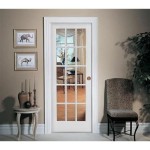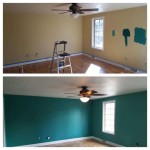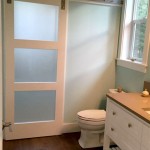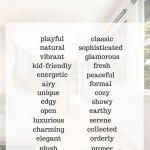Which Is The Best Color For Interior House Painting?
Selecting the "best" color for interior house painting is a highly subjective process, dependent on numerous factors unique to each homeowner and living space. There isn't a single, universally superior color; rather, the ideal choice hinges on personal preferences, the room's purpose, existing décor, lighting conditions, and the desired mood and atmosphere one wishes to create. This article will explore the diverse considerations involved in this decision-making process, providing a framework for evaluating color options and making informed choices.
The perception of colour is fundamentally psychological. Colours evoke emotional responses, influence our moods, and can even impact behaviour. Therefore, understanding the psychological impact of various colours is crucial for selecting the right palette for your home. For example, blues and greens are often associated with calmness and serenity, making them popular choices for bedrooms and bathrooms. Reds and oranges, on the other hand, are typically seen as stimulating and energetic, frequently used in dining rooms or living spaces. Whites and neutrals offer a sense of spaciousness and cleanliness but can sometimes feel sterile if not balanced with warmer tones and textures. Ultimately, recognizing these associations ensures that the chosen colours align with the intended purpose and atmosphere of each room.
Beyond the emotional effects, colour plays a significant role in shaping the perceived size and shape of a room. Lighter colours tend to make a space feel larger and more open, as they reflect more light. Conversely, darker colours can make a room feel smaller and more intimate, absorbing light and drawing walls inward. Using these properties strategically can visually alter the dimensions of a room. For example, a small room could benefit from light colours on the walls and ceiling to maximize its perceived size. In contrast, a large, open room might benefit from darker accent walls to create a sense of coziness and definition. The strategic use of colour creates a visual equilibrium, making the most of a space's architectural features.
Natural and artificial lighting significantly influence how colours appear in a room. The intensity and direction of light can alter the hue and saturation of paint, making it appear different at various times of the day. Rooms with abundant natural light often allow for a wider range of colour choices, as natural light generally enhances the vibrancy of colours. However, rooms with limited natural light may require lighter, brighter shades to prevent them from feeling dark and gloomy. Artificial lighting, such as incandescent, fluorescent, and LED lights, also casts different tones that can affect colour perception. Incandescent lights tend to emit a warm, yellowish glow, while fluorescent lights can cast a cooler, bluish tint. LED lights offer a wider spectrum of options, allowing for more neutral and accurate colour representation. Considering these lighting factors is essential for ensuring that the chosen paint colour looks consistent and appealing under different lighting conditions.
Understanding the Psychology of Color in Interior Design
The application of colour psychology in interior design is a deliberate effort to create spaces that resonate with the desired emotional and mental states. Different colours are associated with various feelings, and understanding these associations allows for the creation of environments that promote specific moods and behaviors. For instance, blue is typically associated with calmness, tranquility, and stability. It's often chosen for bedrooms, bathrooms, or home offices to create a soothing and focused environment. Green, similarly, is associated with nature, growth, and balance. It is often used in living rooms or bedrooms to promote relaxation and a sense of harmony. Yellow represents optimism, happiness, and creativity, making it a good choice for kitchens, dining rooms, or children's playrooms. Red, being a high-energy colour, can stimulate appetite and conversation, making it suitable for dining rooms or accent walls in living rooms. However, excessive use of red can be overwhelming, so it's often best used sparingly.
Neutrals, such as white, gray, beige, and taupe, serve as versatile foundations in interior design. They create a sense of spaciousness and cleanliness, providing a backdrop that allows other colours and elements to stand out. White is associated with purity, simplicity, and openness, making it a popular choice for walls and ceilings. Gray is a sophisticated and versatile neutral that can range from cool and modern to warm and inviting, depending on its undertones. Beige and taupe offer warmth and comfort, creating a cozy and inviting atmosphere. When using neutrals, it's important to consider adding texture and visual interest through furniture, accessories, and artwork to avoid a monotonous look. Layering different shades of neutrals can also create depth and dimension, adding complexity to the overall design.
In addition to individual colours, colour combinations play a crucial role in shaping the overall atmosphere of a room. Complementary colour schemes, which pair colours opposite each other on the colour wheel (e.g., blue and orange, red and green), create a vibrant and dynamic contrast. Analogous colour schemes, which use colours adjacent to each other on the colour wheel (e.g., blue, blue-green, and green), create a harmonious and soothing effect. Monochromatic colour schemes, which use different shades and tints of a single colour, create a sense of unity and sophistication. The choice of colour combination should align with the desired mood and style of the room. For example, a living room designed for relaxation might benefit from an analogous colour scheme in calming blues and greens, while a dining room designed for conversation and entertainment might benefit from a complementary colour scheme in warm reds and oranges.
Considering Room Function and Existing Décor
The intended function of a room is a primary factor in determining the most appropriate colour scheme. High-energy spaces, such as kitchens and home gyms, often benefit from stimulating colours that encourage activity and focus. Warmer tones, like yellows and oranges, promote energy and creativity, while cooler tones, like blues and greens, can foster concentration and productivity. In contrast, rooms designed for relaxation, such as bedrooms and bathrooms, often benefit from calming colours that promote rest and tranquility. Soft blues, greens, and lavenders create a serene and restful atmosphere, while warm neutrals can provide a sense of comfort and coziness. The selection of colour should align with the activities that will be performed in the room to enhance its functionality and create a cohesive environment.
The existing décor, including furniture, flooring, and accessories, should be carefully considered when choosing paint colours. Ideally, the new paint should complement and enhance the existing elements, rather than clashing with them. Analyze the undertones of existing furniture and textiles to determine whether warm or cool colours would be more suitable. For example, if the furniture has warm, yellow undertones, paint colours in warm whites, beiges, or earthy greens will likely create a harmonious effect. Conversely, if the furniture has cool, blue undertones, paint colours in cool grays, blues, or lavenders may be a better choice. Consider the colours of the flooring as well. Dark hardwood floors can provide a grounding element that pairs well with a wide range of paint colours, while light-coloured carpets may require softer, more muted tones to avoid creating harsh contrasts. Incorporating existing colours into the new colour scheme creates a cohesive and visually appealing space.
Maintaining a consistent colour palette throughout the home is often desirable to create a sense of flow and unity. This doesn't necessarily mean using the same colour in every room, but rather selecting a limited range of colours that complement each other and are used in varying shades and combinations throughout the house. For example, a neutral base colour, such as a warm white or light gray, can be used as the primary wall colour throughout the house, with accent colours used in specific rooms to create interest and variation. Using a consistent colour palette creates a sense of continuity and harmony, making adjacent rooms feel connected and visually cohesive. This approach can be particularly effective in open-concept living spaces where different areas flow seamlessly into one another. Maintaining a consistent colour story enhances the overall aesthetic appeal of the home and creates a unified and inviting atmosphere.
Practical Considerations: Lighting and Room Size
The amount and type of natural light a room receives drastically influences how paint colours appear. South-facing rooms tend to receive warm, yellow light throughout the day, which can enhance the vibrancy of warm colours and make cool colours appear more muted. North-facing rooms, on the other hand, typically receive cooler, indirect light, which can make warm colours appear duller and cool colours appear more vibrant. East-facing rooms receive the most light in the morning, with warm, early sunlight that can brighten up the space. West-facing rooms receive the most light in the afternoon, with warm, late-day sunlight that can create a cozy and inviting atmosphere. When selecting paint colours, it's essential to consider the direction the room faces and how the light will affect the appearance of the chosen colours at different times of the day. Testing paint samples on the walls in different lighting conditions is crucial for ensuring that the colour looks as expected.
Artificial lighting also plays a significant role in colour perception. Incandescent bulbs emit a warm, yellowish light that can enhance warm colours and make cool colours appear less vibrant. Fluorescent bulbs emit a cool, bluish light that can enhance cool colours and make warm colours appear duller. LED bulbs offer a wide range of colour temperatures, allowing for more control over the lighting environment. When selecting paint colours, consider the type of artificial lighting that will be used in the room and how it will affect the appearance of the chosen colours. Using bulbs with a neutral colour temperature (around 3000K) can provide a more accurate representation of the paint colours. Additionally, consider the placement of light fixtures and how the light will be distributed throughout the room. Dark corners and poorly lit areas may require lighter paint colours to brighten up the space, while well-lit areas may be able to accommodate darker, more saturated colours.
The size and shape of a room should also be considered when choosing paint colours. Lighter colours tend to make a room feel larger and more open by reflecting light. Darker colours tend to make a room feel smaller and more intimate by absorbing light. In small rooms, using light colours on the walls and ceiling can create a sense of spaciousness and prevent the room from feeling cramped. Adding vertical stripes or using a lighter colour on the ceiling can visually raise the height of the room. In large rooms, using darker colours on accent walls can create a sense of coziness and define the space. Horizontal stripes can visually widen the room. Consider the proportions of the room and use colour strategically to enhance its architectural features and create a balanced and visually appealing space. For example, in a long, narrow room, painting the end walls a darker colour than the side walls can help to visually shorten the room and create a more balanced proportion.

10 Best Wall Paint Colors For The Home Interior Living Room

20 Of The Best Paint Colors For Whole House Welsh Design Studio

Choosing The Best Interior Paint Colors For Your Home In Fair Oaks Ranch

Best Paint Colors For Ing Your Home In 2024 J Van

What Are The Best Paint Colors For Ing Your House Living Room Home

Best Interior Paint Colors Whole House Color Scheme Abby Organizes

20 Of The Best Paint Colors For Whole House Welsh Design Studio

2024 Best Interior Paint Colors To Your House Homeadvisor

10 Best Trending 2024 Interior Paint Colors To Inspire Décor Aid

You Ll See These Interior Paint Colors Everywhere In 2024
Related Posts








